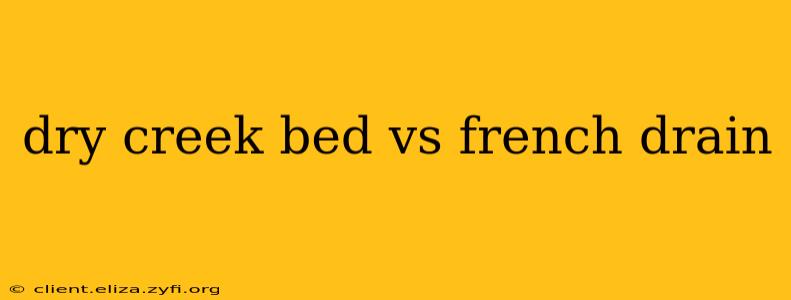Choosing between a dry creek bed and a French drain can be tricky. Both manage excess water, but they serve different purposes and have distinct aesthetic qualities. This guide will help you understand the key differences to make the best choice for your property.
What is a Dry Creek Bed?
A dry creek bed is an aesthetically pleasing landscaping feature designed to mimic a natural creek. It's typically constructed using river rock, gravel, and other natural materials, creating a visually appealing watercourse that directs runoff away from structures and problem areas. While it can help with drainage, its primary function is decorative. Water flows through it only during periods of heavy rainfall or snowmelt. The bed itself doesn't actively drain water; it simply guides it to a designated area.
What is a French Drain?
A French drain, on the other hand, is a fully functioning underground drainage system. It consists of a perforated pipe surrounded by gravel or other porous material. This system actively collects and redirects subsurface water away from foundations, roads, and other areas prone to water damage. It's primarily a functional solution, though it can be subtly incorporated into landscaping to minimize its visual impact.
H2: Key Differences: Dry Creek Bed vs. French Drain
Here's a table summarizing the key differences:
| Feature | Dry Creek Bed | French Drain |
|---|---|---|
| Primary Function | Decorative, minor drainage | Subsurface drainage, water management |
| Water Handling | Guides surface runoff | Collects and redirects subsurface water |
| Visibility | Highly visible, aesthetically pleasing feature | Typically hidden underground, minimal visual impact |
| Maintenance | Minimal, occasional debris removal | Requires periodic inspection and cleaning |
| Cost | Generally less expensive to install | Typically more expensive to install |
| Materials | River rock, gravel, plants | Perforated pipe, gravel, fabric |
H2: When to Use a Dry Creek Bed?
Consider a dry creek bed if:
- You need a decorative landscaping feature: It can add visual interest to your yard and create a natural-looking water feature.
- You have mild drainage issues: It can help manage surface runoff, but not significant subsurface water problems.
- You want a low-maintenance solution: It requires minimal upkeep.
- Your budget is limited: Dry creek beds are generally less expensive than French drains.
H2: When to Use a French Drain?
Consider a French drain if:
- You have significant drainage problems: It's ideal for managing large volumes of subsurface water.
- You need to protect your foundation or other structures: It prevents water damage caused by excessive moisture.
- You want a hidden solution: The drain is buried underground, minimizing its visual impact.
- You have consistently wet or soggy areas: It effectively removes excess water from the soil.
H2: Can I Combine a Dry Creek Bed and a French Drain?
Yes! A common and effective approach is to use a French drain to handle the subsurface water and then incorporate a dry creek bed to manage surface runoff and enhance the aesthetics. The French drain would be hidden underground, while the dry creek bed would provide a visually appealing surface drainage channel.
H2: What is the average cost of a dry creek bed?
The cost of a dry creek bed varies depending on the size, materials used, and labor costs. Expect to pay anywhere from a few hundred dollars for a small installation to several thousand for a larger, more elaborate design.
H2: What is the average cost of a French drain?
Similar to a dry creek bed, the cost of a French drain depends on the project’s scope and complexity. Expect costs to range from a few hundred dollars for smaller projects to several thousand dollars for larger installations involving significant excavation and pipework.
Conclusion
Choosing between a dry creek bed and a French drain depends entirely on your specific needs and priorities. If you primarily need a decorative element with some drainage capabilities, a dry creek bed is a good option. If you require a robust and effective solution for subsurface drainage, a French drain is necessary. In many cases, a combination of both provides the best of both worlds, offering both functionality and aesthetic appeal. Remember to consult with a landscaping professional to determine the best solution for your specific property and drainage challenges.
